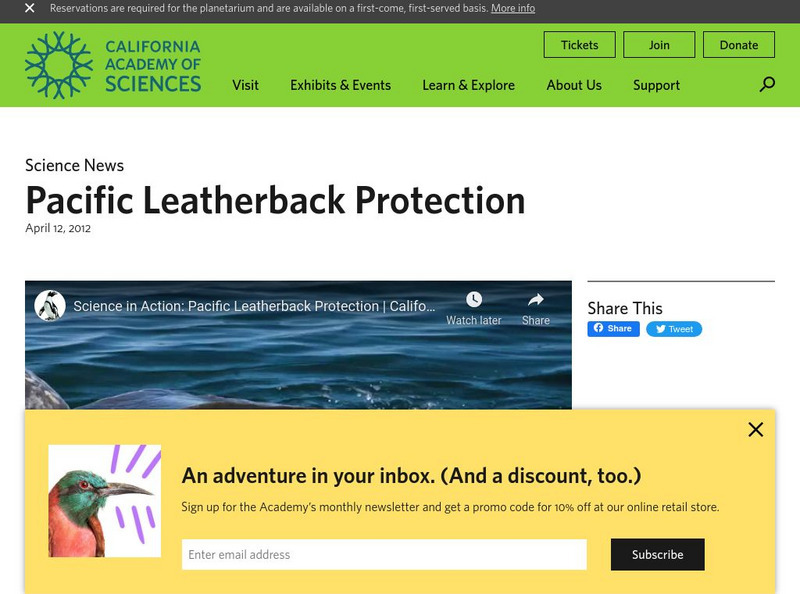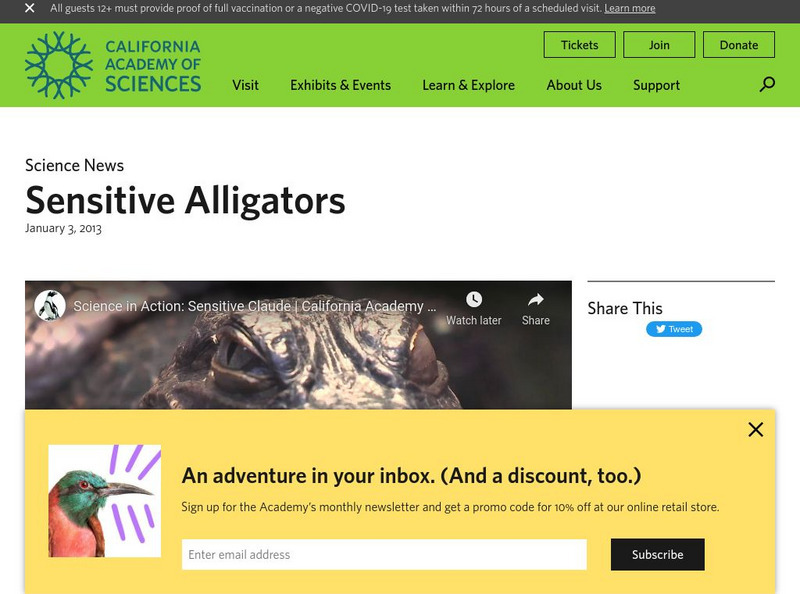Hi, what do you want to do?
California Academy of Sciences
California Academy of Sciences: Infant Galaxies
The Hubble Telescope's latest image shows 13 billion-year-old infant (and still forming) galaxies. [1:25]
California Academy of Sciences
California Academy of Sciences: John Mc Cosker Interview
An interview with Dr. John McCosker, a scientist at the California Academy of Sciences. Learn about his experiences with Great White sharks. [5:31]
California Academy of Sciences
California Academy of Sciences: Leatherback Turtles Along the California Coast
Marine ecologist Scott Benson discusses the Leatherback turtle (Dermochelys coriacea) population along the California coast. Learn about Leatherback turtles in coastal central California and their origins in the remote beaches of...
California Academy of Sciences
California Academy of Sciences: Science Informing Art
The Maya Lin sculpture at the California Academy of Sciences is art informed by science. "What is Missing?" is a memorial to extinct and endangered species. [2:31]
California Academy of Sciences
California Academy of Sciences: Mimic Octopus
This special octopus (Thaumoctopus mimicus) mimics other marine animals as a form of defense. How did it evolve to do this? [2:15]
California Academy of Sciences
California Academy of Sciences: Oakmapper
A mobile app, designed by researchers at UC Berkeley, is helping citizens track Sudden Oak Death. [2:40]
California Academy of Sciences
California Academy of Sciences: Ocean Noise Pollution
Marine animals, especially whales, are susceptible to noise in the ocean. Find out what one local group is doing to quiet it down. [1:15]
California Academy of Sciences
California Academy of Sciences: Pacific Leatherback Protection
Pacific leatherback sea turtles are in trouble. See how a recent designation of protected areas is a good start to helping them.
California Academy of Sciences
California Academy of Sciences: Physics for Future Presidents
This piece discusses UC Berkeley professor, Richard Muller's aptly named the Physics for Future Presidents course. Designed to illuminate and educate the leaders of our future, whomever and wherever they may be, it teaches basic physics...
California Academy of Sciences
California Academy of Sciences: Plastics in the Ocean
Plastics are surfacing in our oceans. What's the solution? [3:30]
California Academy of Sciences
California Academy of Sciences: Rafting Ants
When faced with a flood, fire ants go with the flow and float wherever they can go to survive. [1:12]
California Academy of Sciences
California Academy of Sciences: Saving Sea Turtles
The survival of sea turtles is threatened, but fortunately they have a champion. Academy Research Fellow, Wallace J Nichols is pursuing his lifelong passion to help save them for future generations. This is the fascinating story of how...
California Academy of Sciences
California Academy of Sciences: Saving Sea Turtles
Wallace J. Nichols is a California Academy of Sciences researcher who studies and tracks sea turtles. The more he learns about them, the more he realizes they are in serious trouble. [4:22]
California Academy of Sciences
California Academy of Sciences: Science in Action: A Bit of Neanderthal
New research demonstrates that most of us have a bit of Neanderthal in our DNA. [1:46]
California Academy of Sciences
California Academy of Sciences: Science in Action: Islands, Birds, and Disease
Researcher Jack Dumbacher returns to Papua New Guinea each year, always finding something new.
California Academy of Sciences
California Academy of Sciences: Science in Action: The Sustainability of Chocolate
Humans eat a lot of chocolate. The cacao plant is in trouble! [2:54]
California Academy of Sciences
California Academy of Sciences: Sea Lion Disappearance
Why have the California sea lions disappeared from Pier 39? And where have they gone? [2:15]
California Academy of Sciences
California Academy of Sciences: Seismic Hazards in Haiti
In 2008, a team of scientists warned that a large earthquake could hit Haiti. Local geologist, Carol Prentice, who was part of that team, discusses how they came to that conclusion and how the Bay Area could be next. [3:10]
California Academy of Sciences
California Academy of Sciences: Sensitive Alligators
Alligators and crocodiles are more sensitive than you might think. [2:05]
California Academy of Sciences
California Academy of Sciences: Spiky Sight
Sea urchins have no eyes or visual organs, but researchers are proving that they do, in fact, see. [1:36]
California Academy of Sciences
California Academy of Sciences: Sustainable Collecting
Aquarium biologists travel to Costa Rica to gather animals for Academy exhibits. [4:23]
California Academy of Sciences
California Academy of Sciences: Sustainable Seafood
How can you ensure the seafood you're eating is sustainable? Ask a lot of questions. [4:02]
California Academy of Sciences
California Academy of Sciences: Terry Gosliner: Chat With an Academy Scientist
In this chat, Geoff discusses Nudibranchs, researching in the Philippines, and other expeditions with Academy Scientist Terry Gosliner.
California Academy of Sciences
California Academy of Sciences: The Center for Comparative Genomics
Take a peek into the Academy's Center for Comparative Genomics with the lab's director, Brian Simison. Learn how cutting-edge technology is changing the way our scientists work.




























